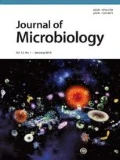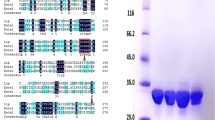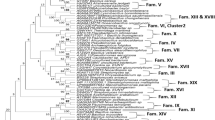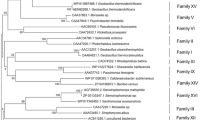Abstract
Thermostable esterase gene was cloned (Est-AF) from extremophilic microorganisms, Archaeoglobus fulgidus DSM 4304. The protein analysis result showed that Est-AF is monomer with total 247 amino acids and molecular weight of estimated 27.5 kDa. It also showed repeating units G-X-S-X-G (GHSLG) (residues 86∼90) which is reported as active site of known esterases, and the putative catalytic triad composed of Ser88, Aspl98 and His226. The esterase activity test with various acyl chain length of ρ-nitrophenol resulted that Est-AF showed highest specific activity with ρ-nitrophenylbutyrate (PNPC4) and rapidly decrease with ρ-nitrophenyl ester contain more than 8 carbon chain. These results represent that cloned enzyme is verified as a carboxylesterase but not a lipase because esterase activity is decreased with ρ-nitrophenyl ester contains more than 8 carbon chains but lipase activity does not affected with carbon chain length. Optimum temperature of esterase reaction with ρ-nitrophenylbutyrate (pNPC4) was 80°C. When ketoprofen ethyl ester was used as a substrate, activity of Est-AF showed the highest value at 70°C, and 10% of activity still remains after 3 h of incubation at 90°C. This result represents Est-AF has high thermostability with comparison of other esterases that have been reported. However, Est-AF showed low enantioselectivity with ketoprofen ethyl ester. Optimum pH of Est-AF is between pH 7.0 and pH 8.0. Km value of ketoprofen ethyl ester is 1.6 mM and, Vmax is 1.7 µmole/mg protein/min. Est-AF showed similar substrate affinity but slower reaction with ketoprofen ethyl ester compare with esterase from mesophilic strain P. fluorescens.
Similar content being viewed by others
References
Akoh, C.C., G.-C. Lee, Y.-C. Liaw, T.-H. Huang, and J.-F. Shaw. 2004. GDSL family of serine esterases/lipases. Prog. Lipid Res. 43, 534–552.
Alessandra, M., D.P. Natascia, V. Aurilia, R. Mose, and C. Raffaele. 2002. A carboxylesterase from the hyperthermophilic archaeon Sulfolobus solfataricus: cloning of the gene, characterization of the protein. Gene 283, 107–115.
Borman, S. 1990. Chirality emerges as a key issues in pharmaceutical research. Chem. Eng. News 68, 9–14.
Bornscheuer, U.T. 1997. Directed evolution of an esterase for the stereoselective resolution of a key intermediate in the synthesis of epothilones. Biotechnol. Bioeng. 58, 554–559.
Bornscheuer, U.T. 2002. Microbial carboxyl esterases: classification, properties and application in biocatalysis. FEMS Microbiol. Rev. 733, 1–9.
Chasse, G.A., A.M. Rodrigues, M.L. Mak, E. Deretey, A. Perczel, C.P. Sosa, R.D. Enriz, and I.G. Csizmadia. 2001. Peptide and protein folding. J. Mol. Struct. (Themochem) 537, 319–361.
Choi, G.-S. 2001. PCR-Cloning and purification of an esterase from Pseudomonas fluorescens KCTC 1767 with high activity toward (S)-Ketoprofen ethyl ester. MSc. thesis. Ajou University, Suwon, Korea.
Claire, V., D. Sriprapundh, A. Savchenko, S. Kang, H. Krishnamurthy, and J.G. Zeikus. 2001. Thermostability mechanisms in enzymes from Thermotoga neapolitana and Pyrococcus furious. J. Microbiol. 39, 245–249.
Ewis, H.E., A.T. Abdelal, and C.-D. Lu. 2004. Molecular cloning and characterization of two thermostable carboxyl esterase from Geobacillus stearothermophilus. Gene 329, 187–195.
Faber, K. and M.C.R. Franssen. 1993. Prospects for the increase application of biocatalysts in organic transformations. Trends Biotechnol. 11, 461–470.
Gong, P.-F., H.-Y. Wu, J.-H. Xu, D. Shen, and Y.-Y. Liu. 2002. Biocatalytic preparation of enantiopure (R)-ketoprofen from its racemic ester by a new yeast isolate Citeromyces matriensis CGMCC 0573. Appl. Microbiol. Biotechnol. 58, 728–734.
Henke, E. and U.T. Bornscheuer. 2002. Esterases from Bacillus subtilis and B. stearothermophilus share high sequence homology but differ substantially in their properties. Appl. Microbiol. Biotechnol. 60, 320–326.
Jaeger, K.E., B.W. Dijkstra, and M.T. Reetz. 1999. Bacterial biocatalysts: molecular biology, three-dimensional structure, and biotechnology applications of lipases. Annu. Rev. Microbiol. 53, 315–351.
John, V.T. and G. Abraham. 1991. Lipase catalysis and its application. In J.S. Dordick (ed.), Biocatalysts for industry. Plenum press, New York, NY, USA.
Kim, J.-H., G.-S. Choi, S.-B. Kim, W.-H. Kim, J.-Y. Lee, Y.-W. Ryu, and G.-J. Kim. 2004. Enhanced thermostability and tolerance of high substrate concentration of an esterase by directed evolution. J. Mol. Catal. B: Enzymatic 27, 169–175.
Liu, A.M.F., N.A. Somers, R.J. Kazlauskas, T.S. Brush, F. Zocher, M.M. Enzelberger, U.T. Bornscheuer, G.P. Horsman, A. Mezzetti, C. Schmidt-Dannert, and R.D. Schmid. 2001. Mapping the substrate selectivity of new hydrolases using colorimetric screening: lipases from Bacillus thermocatenulatus and Ophiostoma piliferum, esterases from Pseudomonas fluorescens and Streptomyces diastatochromogenes. Tetrahedron Asymmetry 12, 545–556.
Manco, G., E. Giosue, S. D’Auria, P. Herman, G. Carrea, and M. Rossi. 2000. Cloning, overexpression, and properties of a new thermophilic and thermostable esterase with sequence similarity to Hormone-sensitive lipase subfamily from the Archaeon Archaeoglobus fulgidus. Arch. Biochem. Biophys. 373, 182–192.
Margolin, A.L. 1993. Enzymes in the synthesis of chiral drugs. Enzyme Microb. Technol. 15, 266–280.
Ollis, D., E. Cheah, M. Cygler, B. Dijkstra, F. Frolow, S. Franken, M. Harel, S. Remington, I. Silman, and J. Schrag. 1992. The alpha/beta hydrolase fold. Protein Eng. 5, 197–211.
Phytian, S.J. 1998. Esterases, p. 193–241. In D.R. Kelly (ed.), Biotechnology, 2nd ed., Vol. 8s. Wiley-VCH, Weinheim, Germany.
QIAGEN. 2002. A handbook for high-level expression and purification of 6× His-tagged proteins, Fifth edition.
Roberts, S.M. 1999. Biocatalysts for fine chemicals synthesis. John Wiley & Sons, Chichester, UK.
Shinsuke, F. 2002. Extremophiles: Developments of their special functions potential resources. J. Biosci. Bioeng. 94, 518–525.
Shinsuke, F., S. Fujiwara, T. Imanaka, and M. Takagi. 2001. Conformational stability of a hyperthermophilic protein in various condition for denaturation. Electrochemistry 69, 949–952.
Urakami, T. and K. Komagata. 1981. Electrophoretic comparison of enzymes in the Gram-negative methanol-utilizing bacteria. J. Gen. Appl. Microbiol. 27, 381–403.
Vieille, C. and G.J. Zeikus. 2001. Hyperthermophilic enzymes: source, uses, and molecular mechanism for thermostability. Mol. Biol. Rev. 65, 1–43.
Author information
Authors and Affiliations
Corresponding author
Rights and permissions
About this article
Cite this article
Kim, SB., Lee, W. & Ryu, YW. Cloning and characterization of thermostable esterase from Archaeoglobus fulgidus . J Microbiol. 46, 100–107 (2008). https://doi.org/10.1007/s12275-007-0185-5
Received:
Accepted:
Published:
Issue Date:
DOI: https://doi.org/10.1007/s12275-007-0185-5




